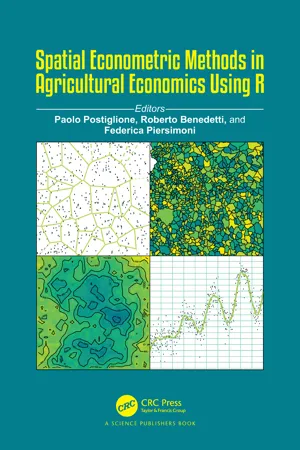Geography
Sample Size
Sample size refers to the number of observations or individuals included in a research study or survey. In geography, sample size is crucial for ensuring the reliability and representativeness of data collected from a specific geographic area. A larger sample size generally leads to more accurate and generalizable results, while a smaller sample size may introduce more variability and potential bias.
Written by Perlego with AI-assistance
Related key terms
10 Key excerpts on "Sample Size"
- eBook - ePub
Research Methodology
A Step-by-Step Guide for Beginners
- Ranjit Kumar(Author)
- 2018(Publication Date)
- SAGE Publications Ltd(Publisher)
From sample statistics we make an estimate of the possible answers to our research questions for the study population. The estimates arrived at from sample statistics are called population parameters. One example of a parameter is the population mean. Study population: Every study in the social sciences has two aspects: study population and study area (subject area). The people you want to find out about are collectively known as the study population or simply population; the size of the population is usually denoted by the letter N. It could be a group of people living in an area, employees of an organisation, a community, a group of people with special issues, etc. The people from whom you gather information, known as the sample, are selected from the study population; the Sample Size is usually denoted by n. Sample: A sample is a subgroup of the population which is the focus of your research enquiry and is selected in such a way that it represents the study population. A sample is composed of a few individuals from whom you collect the required information. It is done to save time, money and other resources. Sample Size: The number of individuals, usually denoted by the letter n, from whom you obtain the required information. Sampling design: The way you select the required sampling units from a sampling population to obtain your sample is called the sampling design or sampling strategy - Nigel Walford(Author)
- 2011(Publication Date)
- Wiley(Publisher)
2 Geographical data: quantity and content2.1 Geographical dataLearning outcomes This chapter will enable readers to:Chapter 2 starts to focus on geographical data and looks at the issue of how much to collect by examining the relationships between populations and samples and introduces the implications of sampling for statistical analysis. It also examines different types of geographical phenomena that might be of interest and how to specify attributes and variables. Examples of sampling strategies that may be successfully employed by students undertaking independent research investigations are explained in different contexts.- outline the relationship between populations and samples, and discuss their implications for statistical analysis;
- decide how much data to collect and how to specify the attributes and variables that are of interest in different types of geographical study;
- initiate data-collection plans for an independent research investigation in Geography and related disciplines using an appropriate sampling strategy.
What are geographical data? Answering this question is not as simple as it might at first appear. The geographical part implies that we are interested in things – entities, observations, phenomena, etc. – immediately above, below and on, or indeed comprising, the Earth’s surface. It also suggests that we are interested in where these things are, either as a collection of similar entities in their own right or as one type of entity having a spatial relationship with another type or types. For example, we may wish to investigate people in relation to settlements; rivers in respect of land elevation; farms in association with food-industry corporations; or volcanoes in connection with the boundaries of tectonic plates. The data part of the term ‘geographical data’ also raises some definitional issues. At one level the data can be thought of as a set of ‘facts and figures’ about ‘geographical things’ . However, some would argue that the reduction of geographical entities to a list of ‘facts and figures’ in this fashion fails to capture the essential complexity of the phenomena. Thus, while it is possible to draw up a set of data items- eBook - ePub
Sampling Essentials
Practical Guidelines for Making Sampling Choices
- Johnnie N. Daniel(Author)
- 2011(Publication Date)
- SAGE Publications, Inc(Publisher)
The rule of homogeneity holds that the more homogeneous the population, the fewer elements are necessary to represent the population. If a population is perfectly homogeneous in terms of the study variables, only one element would be necessary to have a representative sample. Inferences based on homogeneous samples have smaller margins of error than inferences based on heterogeneous samples. It is not unusual for a research project to have multiple key variables with differing variances. In such a situation, one should choose the Sample Size based on the variable for which the greatest precision is required.Guideline 7.5. Spatial distribution of the population. Due to the relationship between the spatial distribution of the population and data collection costs, the more scattered a population, the more consideration should be given to choosing a smaller sample rather than a larger sample. The spatial distribution of a population significantly affects the data collection costs of a study; as a result, the spatial distribution of the population is a critical factor in determining Sample Size. Given availability of funds, a larger sample may not be an option in studying a widely dispersed population. Using cluster sampling may reduce such costs. However, as noted earlier, cluster sampling would yield higher sampling errors, necessitating the sampling of a larger number of clusters and a larger overall Sample Size.Availability of Resources
Guideline 7.6. Availability of resources. The more limited one’s resources (i.e., money, time, facilities, personnel, etc.), the more consideration should be given to choosing a smaller sample rather than a larger sample. The number of elements selected for a research project will primarily be determined by the availability of resources. There is a direct relationship between amount of money, time, facilities, and personnel available to conduct a study and Sample Size. It will be a waste of effort to identify a large number of elements for participation in the study if one does not have the facilities, personnel, and other resources to involve them in the study. If immediate results are required, a large Sample Size may be out of the question. There must be a balance between resources and Sample Size. Using only budget considerations, the Sample Size may be determined by dividing the available funds for data collection by the average data collection cost per element. - eBook - ePub
Researching Health Needs
A Community-Based Approach
- Judy Payne(Author)
- 1999(Publication Date)
- SAGE Publications Ltd(Publisher)
population. A sample is a smaller sub-set of all the possible people who might be included. If it is a properly selected sample it will be representative of the total population of people (or households) who make up your community. Sample Size is discussed later in this chapter.The best way to get a representative sample is to pick people or households in a way that prevents the person doing the selection having any say in who gets drawn, rather like the National Lottery draw. This is called random sampling, the word ‘random’ being a technical term meaning that the selection is not biased to over-represent any one group. Sometimes random sampling is referred to as probability sampling. This is because, in the process of selection, everyone has an equal (in simple random sampling) or known (in stratified sampling) chance or probability of being selected. If you are undertaking quantitative research, provided you have a random sample, it is possible to do statistical analysis on the data you collect.The overall answers you obtain from a good sample will be very close indeed to the answers you would have obtained if you had questioned everybody. It is true that the sample’s answers are only estimates, and you need to remember this in reporting what you find out. However, if all aspects of the research are properly carried out, the estimates based on the sample will be very close to what the whole population would say. With a random sample, you can calculate just how close by using confidence levels: research reports sometimes say things like ‘The proportion saying they visited their GP in the last year was 45 per cent, plus or minus 2 per cent’. What this means is that the researchers know that 45 per cent of the sample did it, and it can be estimated that between 43 per cent and 47 per cent of the population did it. Confidence levels are discussed in Chapter 9 - eBook - ePub
- Patricia Cronin, Michael Coughlan, Valerie Smith(Authors)
- 2014(Publication Date)
- SAGE Publications Ltd(Publisher)
The methods used to select a sample vary, depending on the type of research being undertaken and what the researcher is attempting to achieve. The size of the sample will also vary. Studies that collect numerical data will usually have a bigger Sample Size than those that collect narrative (words) data. However, researchers are sometimes forced to compromise on their Sample Size because of issues such as the availability of participants or time constraints on the study. The purpose of this chapter is to introduce the reader to the different approaches used in selecting samples and how different sampling methods are used to support the underlying philosophical principles of the methodology selected.Learning Outcomes
By the end of this chapter you should be able to:- List the different types of sample
- Identify the different techniques used to select samples
- Differentiate between probability and non-probability sampling methods
- Discuss the importance of Sample Size.
Populations
A population may be defined as all the components that are deemed to have one or more common characteristics and therefore constitute a group. The characteristics of this group are determined by the researcher and may consist of people, artefacts, incidents or materials depending on the focus of the research. In health science research populations commonly refer to people. However, where other items are used as sources of data, the principles underpinning the identification of populations and samples are similar.As previously stated a population is all of the individuals or items that share one or more criteria that are predetermined by the researcher. In the case of a ‘quinquennial’ or a ‘decennial’ census, this is all the individuals who are resident in the country on one pre-arranged night. In this case, all living individuals in the country meet the criteria and therefore form the target population. Thus, a census of the population is not a sample because all of the individuals in the target population are included in the study. - eBook - ePub
Understanding Research Methods
A Guide for the Public and Nonprofit Manager
- Donijo Robbins(Author)
- 2017(Publication Date)
- Routledge(Publisher)
4 How is a Sample Size of 1001 acceptable to generalize to a population of 209 million? This chapter answers this question by discussing the different sampling methods, and the confidence, accuracy, and errors in the sampling process. However, before discussing some of the different sampling techniques available to researchers, we begin with some definitions.7.2 Some Definitions
A sample is a representative subset of units of the population. Elements or units refer to the unit of analysis, and are the people, places, or objects from which researchers obtain their data. The population is the group of interest to which the study’s findings will be generalized; for example, all public administration students from accredited institutions, tenured professors from RUVH institutions (research university with very high research activities), nonprofits with assets worth $ 100 million or more, or Americans. Most often, however, researchers do not have access to the entire population of interest; therefore, they develop a sampling frame. The sampling frame is the list of elements that is accessible to the researcher; for example, a list of cities with population more than 100,000, nonprofit organization board members, college alumni lists, or voter registration lists. Therefore, sampling is the process of selecting elements from the sampling frame.Researchers analyze the information collected in aggregate (whole) form to determine statistics, that is, percentages, averages, standard deviations, and medians. For example, in the Gallup Poll mentioned earlier, 75% of the units in the sample responded that it is unacceptable for presidential hopefuls to accept money from lobbyists. Researchers use these statistics to draw conclusions about the sample and make inferences and generalizations about the population. The use of proper sampling techniques improves the validity of the findings—the researcher’s ability to generalize sample findings to the target population. Figure 7.1 illustrates this principle.From the population, researchers draw a representative sample, collect data, run statistical analyses, calculate the findings, and draw conclusions. These findings and conclusions are generalized back to the population of interest. For example, the Gallup Poll claims the following in its report: - eBook - ePub
Research Methods and Society
Foundations of Social Inquiry
- Linda Eberst Dorsten, Lawrence Hotchkiss(Authors)
- 2018(Publication Date)
- Routledge(Publisher)
Taking a national census is a major operation. For example, in the U.S. every household in the country must be listed. Every institution that houses people must be identified such as prisons, nursing homes, children’s homes, and psychiatric hospitals. Then there are homeless people who do not live in any dwelling but by law must be counted. Next, the data must be collected, then computer processed, and then distributed to the many individuals, agencies, and businesses that make use of census data. When there are over 308 million entries, every seemingly minor operation is truly a massive undertaking. The question, “Why take a sample instead of a complete count?” answers itself—for people, potatoes, and many other items.In the case of survey research, the choice is usually between selecting a sample and doing no study, because money and time costs nearly always rule out a complete count. Of course, not all populations are as large as the entire U.S. population. However, even for your hometown, surveying all persons generally exceeds a reasonable budget. Consequently, nearly all surveys are based on samples rather than on a census.Basic Concepts
In sampling language, element refers to the objects to be described, such as people, families, cities, magazine ads, and so forth. And in qualitative research, elements might be social interactions.A population is a collection of elements. And a sample consists of some, but not all, of the elements in a population. The population for a study is defined according to the goals of the study and is often restricted by practical limitations. For example, many survey populations of the U.S. are limited to “all U.S. civilian adults, 18 years old and older, living in the continental U.S. and not living in an institution.”There are two major types of samples: a probability sample and a non-probability sample. For a probability sample, each element in its population has a known, non-zero probability (chance) of selection into the sample. Suppose, for example, there are 30 students in your class. Your instructor writes each student’s name on a separate piece of paper, places the paper slips in a hat, thoroughly mixes the slips, and pulls one out. That person gets to answer the next question posed by the instructor. What’s the chance your name is drawn? - eBook - ePub
Dissertation Research Methods
A Step-by-Step Guide to Writing Up Your Research in the Social Sciences
- Philip Adu, D. Anthony Miles(Authors)
- 2023(Publication Date)
- Routledge(Publisher)
Sampling is frequently employed to estimate the sizes of populations, groups and other types of populations. The practice of sampling has so many more uses for research. When researchers gather information obtained from properly selected populations, it can give rise to an interesting sample. The researcher must remember that the sample is selected from the sampling frame, which is a list of all the units from a population to be surveyed. Consider that the sampling frame will contain all the units of the population under consideration, which includes the target population. For example, many qualitative methods texts offer valuable types of sampling methods. Consider the theoretical sampling method. This aspect of theoretical sampling refers to data gathering directed by emerging concepts. With theoretical sampling, the researcher follows the process of the trailing of concepts, looking for sites, persons or events that will enable further comparisons of data.In this chapter, we provide an introduction to many elements associated with sampling methods and define the basic terminology and underlying principles of sampling. The chapter goes on to explain sampling strategies and approaches to both quantitative and qualitative methodologies. The chapter also provides an introduction to sampling techniques to identify the differences between groups and populations.Population, Sampling and Definitions
There are different terms that need to be introduced before we get into the finer points of sampling. There are some terms and definitions that need to be underscored.A population is defined as an aggregate of units such as people, households, cities, districts, countries, states or provinces. It is also an entire group of people, events or things of interest that the researcher wishes to investigate (Rao, 2000 ; Upton & Cook, 2008 ; Sekaran & Bougie, 2013 ; Yaremko et al., 2013 ). A population under investigation depends on the nature of the investigation. A population may be homogenous or heterogeneous. A population can be homogenous when its every element is similar to each other in all aspects and when its elements are not similar to each other in all aspects. The variables that make a population heterogeneous can vary greatly from research to research. Common variables that make a population heterogeneous are gender, age, ethnicity, socioeconomic status and so on (Zedeck, 1986 ; Alvi, 2016 - eBook - ePub
Internet, Phone, Mail, and Mixed-Mode Surveys
The Tailored Design Method
- Don A. Dillman, Jolene D. Smyth, Leah Melani Christian(Authors)
- 2014(Publication Date)
- Wiley(Publisher)
We now focus on the general relationship between Sample Size and the reduction of sampling error in the context of simple random sampling. In what follows, we do not discuss the statistical theory and proofs that underlie the development of these types of designs because they are beyond the scope of this book. Many excellent texts focus exclusively on the various types of sampling designs used in survey research and provide far more detail than can be covered here (these include Levy & Lemeshow, 2008; Lohr, 1999; Maxim, 1999). In addition, the classic sampling texts by Kish (1965) and Cochran (1977) are helpful in describing the foundation of these sampling methodologies. Our goal is to give the reader a sense of the basics underlying sample designs, Sample Size, and the resulting sampling error.How Large Should a Sample Be?
One of the first key decisions in sampling is deciding how large of a sample needs to be drawn. What is an appropriate Sample Size will be determined by- The desired level of confidence one wishes to have in the estimates
- How much sampling error can be tolerated
- How much variation there is in the population on the characteristic of interest
- The size of the population from which the sample is to be drawn
If, for example, one wishes to estimate the percentage of people who have a college education in a small county of 25,000 adults within 3 percentage points of the actual percentage 95% of the time, a completed sample of about 1,100 respondents is needed. If one wants to estimate this characteristic for a small state of 2 million adults with the same confidence, then about 1,100 respondents also are needed. If this information is sought for the entire United States, then the same number—about 1,100—is needed.These examples demonstrate one of the primary characteristics of probability sampling: It is the size of the sample that affects precision, not the size of the population. The formula below can be used to determine what size completed sample is needed, when a simple random sample is employed. The formula takes into account how much confidence is needed for the estimates, the expected distribution for the characteristic of interest being measured in the survey, the amount of sampling error that is desired, and the size of the population. - Paolo Postiglione(Author)
- 2021(Publication Date)
- CRC Press(Publisher)
lemma decomposition and the use of the anticipated variance.The decomposition lemma (Knottnerus 2003 , p.87) states that, given a sample of size n drawn by a sampling design p(s), the constant and unknown population variance of the variable y̆ is given byσ=y ⌣2V s(+)sy ⌣¯n − 1nE s(,)S2y ⌣, swhere y̆ is the expanded vector of yi /πi , VS (y̆– S ) is the variance between samples of HT estimator of the mean according to the design p(s) and ES (S2y̆,S) is the expectation of the sample variances of y̆. From this result, we can observe that HT estimator could be more efficient when the first-order inclusion probabilities are such that the yi /πi s are constant or proportional to y, and/or the design p(s) increases the expected within sample variance. The latter suggests that the p(s) should be proportional or more than proportional to the sample variance S2 . Since this variance is unknown because it is relative to the unobserved variable of interest y
Index pages curate the most relevant extracts from our library of academic textbooks. They’ve been created using an in-house natural language model (NLM), each adding context and meaning to key research topics.









